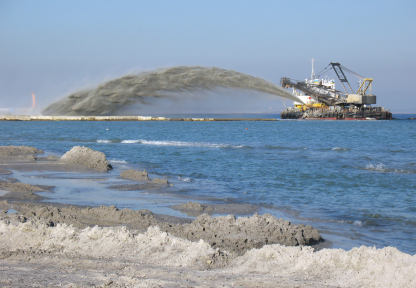Beach nourishment and Natura 2000
The government's decision, in 1990, not to allow the Dutch coastline to erode further, to maintain a 'base coastline', was also an implicit decision to maintain the coast permanently. In the beginning, extra sand from the sea was projected by rainbowing at regular intervals onto the beach at specific locations. At a later stage, beach nourishment in the shallow waters of the coastal area showed itself to be more effective. The amount of sand used in beach nourishment per year is, on average, roughly 12 million m3.

Beach nourishment has a twofold effect on the natural state of the seabed: extraction outside the area of the coastal base (where the depth falls to 20m below the Amsterdam Ordnance Datum) disturbs the sea bed at that point and rainbowing of the sand in the shallow waters of the foreshore has a similar effect. Organisms that live there and on the seabed are buried under a thick layer of extra sand and die as a result. Research has shown that life on the seabed recovers after a few years, although the species composition may be less diverse. Moreover, the question is how long it will take until yet more beach nourishment is needed.
Nonetheless, protection of the hinterland and, as a result, maintaining the coastline, is an urgent priority. Rijkswaterstaat, being the client responsible for beach nourishment, needs a permit and so must do everything in its power to limit the consequences for nature. For each site and each instance of beach nourishment, Rijkswaterstaat describes the measures to be taken, including a justification, in a so-called statement of assurance.